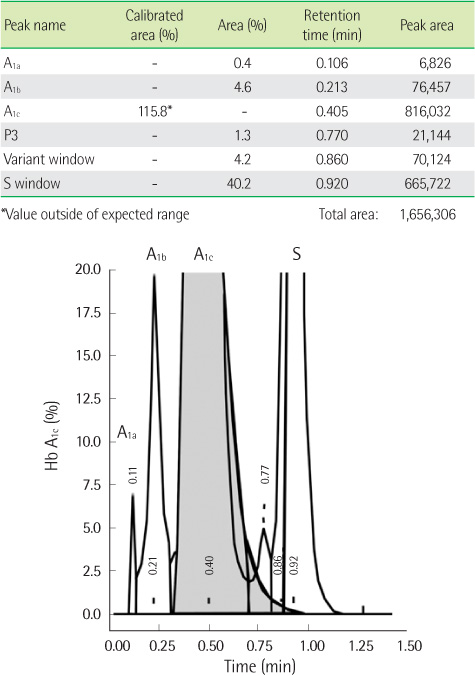Lab Med Online.
2011 Apr;1(2):67-71. 10.3343/lmo.2011.1.2.1.
Translation: Unexpected Hemoglobin A1c Results
- Affiliations
-
- 1Department of Pathology and Laboratory Medicine, Medical University of South Carolina, Charleston, SC, USA.
- KMID: 1446271
- DOI: http://doi.org/10.3343/lmo.2011.1.2.1
Abstract
- No abstract available.
MeSH Terms
Figure
Reference
-
1. American Diabetes Association. Standards of medical care in diabetes - 2010. Diabetes Care. 2010. 33:Suppl 1. S11–S61.2. Bry L, Chen PC, Sacks DB. Effects of hemoglobin variants and chemically modified derivatives on assays for glycohemoglobin. Clin Chem. 2001. 47:153–163.
Article3. Weykamp CW, Penders TJ, Siebelder CW, Muskiet FA, van der Slik W. Interference of carbamylated and acetylated hemoglobins in assays of glycohemoglobin by HPLC, electrophoresis, affinity chromatography, and enzyme immunoassay. Clin Chem. 1993. 39:138–142.
Article4. Mongia SK, Little RR, Rohlfing CL, Hanson S, Roberts RF, Owen WE, et al. Effects of hemoglobin C and S traits on fourteen commercial glycated hemoglobin assays. Am J Clin Pathol. 2008. 130:136–140.
Article5. Ohba Y, Miyaji T, Murakami M, Kadowaki S, Fujita T, Oimomi M, et al. Hb Himeji or β 140 (H18) Ala-Asp. A slightly unstable hemoglobin with increased β N-terminal glycation. Hemoglobin. 1986. 10:109–125.
Article6. Jeppsson JO, Kobold U, Barr J, Finke A, Hoelzel W, Hoshino T, et al. Approved IFCC reference method for the measurement of HbA1c in human blood. Clin Chem Lab Med. 2002. 40:78–89.
Article7. Marchis-Mouren G, Lipmann F. On the mechanism of acetylation of fetal and chicken hemoglobins. Proc Natl Acad Sci U S A. 1965. 53:1147–1154.
Article8. Moo-Penn WF, Bechtel KC, Schmidt RM, Johnson MH, Jue DL, Schmidt DE Jr, et al. Hemoglobin Raleigh (beta1 valine replaced by acetylalanine). Structural and functional characterization. Biochemistry. 1977. 16:4872–4879.
Article9. Chen D, Crimmins DL, Hsu FF, Lindberg FP, Scott MG. Hemoglobin Raleigh as the cause of a falsely increased hemoglobin A1c in an automated ion-exchange HPLC method. Clin Chem. 1998. 44(6 Pt 1):1296–1301.10. Jain N, Kesimer M, Hoyer JD, Calikoglu AS. Hemoglobin Raleigh results in factitiously low hemoglobin A1c when evaluated via immunoassay analyzer. J Diabetes Complications. 2011. 25:14–18.
Article
- Full Text Links
- Actions
-
Cited
- CITED
-
- Close
- Share
- Similar articles
-
- Performance Evaluation of the ARKRAY ADAMS A1c HA-8180
- The Optimal Cutoff Value of Glycated Hemoglobin for Detection of Diabetic Retinopathy
- Factors Associated with Hemoglobin A1c among Patient Aged 40 years over with Diabetes Mellitus: 2012 Korea Health and Nutrition Examination Survey
- Relationship between Glycemic Control and Diabetic Retinopathy
- Evaluation of HLC-723 G7 Hemoglobin A1c Autoanalyzer



